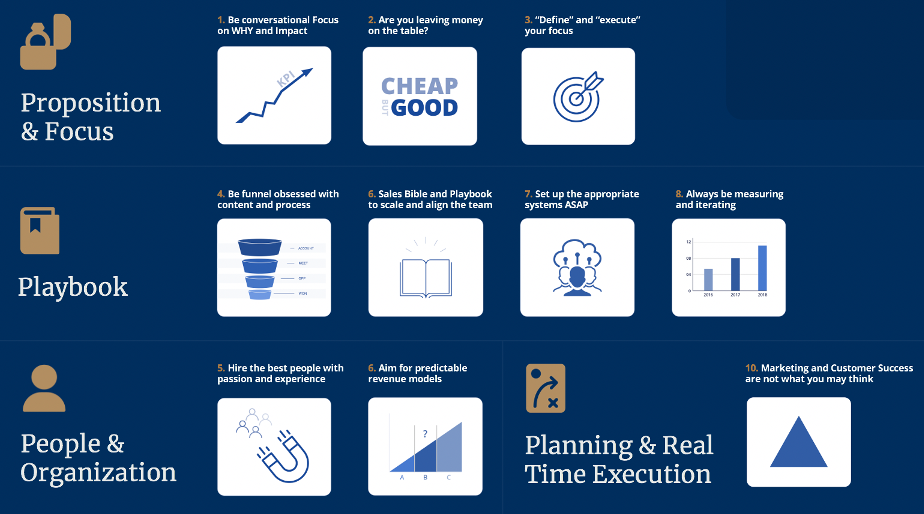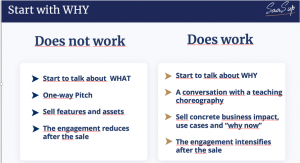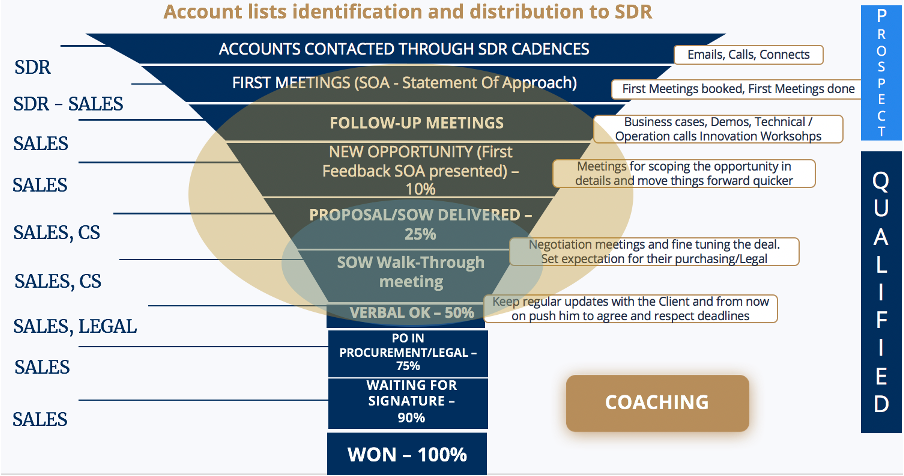Thanks to “The Last Dance” on Netflix many people know that Phil Jackson was the head coach of the Chicago Bulls, leading them to six NBA championships. Not everyone knows that he then coached the Los Angeles Lakers winning further 5 championships and his secret formula was a game plan: The Triangle.
For gaining traction in B2B SaaS, primarily in Middle Market and Enterprise, you also need a game plan made of 4 Pillars.
Table of Contents
The four Pillars

People & Organization
In a previous post about the 3 main types of CEOs we already discussed why in order to execute “efficiently” from scratch you should start from the bottom, not from the top.
Before hiring the VP Sales you should first build a team of 5-10 people:
- Three-four SDRs.
- At least two Account Executives “on quota” with proven experience on similar deal sizes.
- One Revenue Operation Lead with experience in Salesforce and B2B SaaS.
- Two Customer Success Managers with B2B SaaS experience on similar ARPA.
To be attractive for good and experienced VPs the company must demonstrate traction and a decent initial sales organization in place. If they realize they have to transform, cut, build from scratch etc, the experienced VPs know that this process can take up to one year and a lot of energy and risk. Many of them, the good ones, will pass.
Watch out for the young pros and their “title inflation”. Would you let someone drive your Ferrari as soon as they got the driving license?
A CEO after initial revenue traction should get asap the recruitment plan ready for the next 12-18 months, including the phasing.
Concerning the sales profiles that are able to deliver quotas of 500K-1M+ in bookings per year, there are no shortcuts neither. Don’t go cheap. Extend the search to key European hubs and go focused. Look for people that have the key skills and proven experience to be successful. Individual contributors motivated by the possibility to join a great project and earn great money.
A great CEO finds a way to tie her stars to the destiny of the company. They’re carrying the day for her. Sales is a hard job, and if someone’s going to succeed, they need to truly believe that what they’re selling is going to be an enormous benefit to the customer. From day one, the good CEO helps her team understand why the product is the equivalent of the cure for the worst sickness for the target customers. It’s that sense of belief in what they are selling that will sustain the people through the frequent drudgery of the sales process.
Proposition & Focus
In recent years Customers have been demanding more depth and expertise. They expect salespeople to teach them things they don’t know. They are the skills of the future, and any sales force that ignores this message does so at its peril.
As soon as the product-market fit is kind of done, the CEO should build a one pager of Strategic Statement to clearly define the foundational why and value proposition of the company. A bigger reason to exist.
You should formalize a Strategic Statement.
You must be clear with the Why/How/What of the business.
Most European companies have a good understanding of what they are selling, and who is buying. They have nice scrolling websites filled with all sort of products features and client case studies. But lots of them are missing a foundational why. A bigger reason to exist. They don’t have a why (much less a why now). And that’s the story you should really be starting with.
You want to create your version of an art gallery, where the goal is to walk the viewer through three rooms in sequence. Room One isn’t about your company at all – it’s about the context of your company. It’s about what you see going on in the broader commercial world that makes you relevant.
Once you have established the context, only then do you head into Room Two and articulate the value – the objective benefits based on roles and industries. That’s when you start drilling a little deeper in order to provide specific role-based advice and relevant case studies. And finally Room Three, what your service really does – its features and mechanics.
As a starting point a template of Strategic Statement would need to include things like (1) market insight and trends (2) company ambition (3) why us (4) how we deliver our why (5) what is that we sell (6) success stories (7) our pricing and business model.
Don’t leave money on the table.
Pricing and the way the business model is communicated to prospects deserve a special place. Pricing is a key growth lever, 4 times more powerful than Customer Acquisition and twice stronger than Retention. Your product could be sitting on vast amount of unrealized value, simply because it hasn’t taken the time to test the market with new pricing strategies. Or because it is not packaged or communicated properly. You don’t need to guess anymore, but you do need to test. It is certain that successful scaleups, generally, update their pricing at least annually (which means they are thinking about pricing constantly throughout the year).
You must have a Teaching Choreography with Use Cases and relevant Success Stories that go straight to the point.
In the last 10 years Sales has entered in a Conversational Era. As the Challenger Sales study has clearly demonstrated, the most important driver of sales success is the capability to be educational and insightful towards the Prospects, challenging their mindsets and proposing a unique perspective of the market and therefore of the company value proposition.
In today’s world Customers are looking to suppliers to help them identify new opportunities to cut costs, increase revenue, penetrate new markets, and mitigate risk in ways they themselves have not yet recognized. Essentially this is the customer voice: “Stop wasting my time. Challenge me. Teach me something new.”

Contrary to conventional wisdom, more traditional selling skills like need analysis are much farther down the list of key drivers of sales success and customer loyalty as far as B2B prospects are concerned. So while sales organizations continue to pour time and money into helping reps to ask better, more incisive questions, these skills prove to be much more weakly associated with loyalty, as customers aren’t looking for reps to anticipate, or “discover”, needs they already know they have, but rather to teach them about opportunities to make or save money that didn’t even know were possible. What these market studies are telling us is that sales success is much less about discovering needs they already know, and much more about teaching them something they don’t know, for example, something new about how to compete more effectively in their world.
However, just as important as the direction of the information flow is the nature of the actual information flowing through them. In the traditional model, it’s customer-generated intelligence valuable to the supplier. In the emerging sales model the direction of the information flow with the prospects is supplier-generated insight valuable to the customer. This is the new physics of sales – it’s like the whole world is spinning in the opposite direction than it used to be a few years ago.
In this perspective, as soon as the Strategic Statement has been defined, you should focus on Product Marketing and build a Teaching Choreography roadmap to guide the sales conversations.
The first meeting in agenda with a prospect is not a demo, as many still practice against all the evidence and industry best practices.
To sell bigger deals you need to say goodbye to features in your initial conversations.
Playbook
If you imagine a Playbook as a set of documents telling the team how the process works, the SDR protocol, the Sales protocol, the Opportunity stages, Salesforce protocol, Tech stack, etc. ; if that’s what you mean, then this is not the real issue. You could build the best Playbook in the SaaS world and it could be worthless.
Playbook is Behavior in Execution, Not Paper.
Basketball provides other good analogies when it comes to Playbook. I will use a statement of Elad Gil in “High Growth Handbook” and adapt it to basketball. “You know why playing a game is fun? Because it has rules, and you have a way to win”. Picture a bunch of people showing in basketball playground with no rules. People are going to get hurt. You don’t know what you are playing for, you don’t know how to win, you don’t know how to score, and you don’t know what the objectives are.
The real challenge is not the process or the tech stack, the real challenge is how to find the right people and help them execute well.
The modern CEO knows that building a world-class revenue engine is a journey, not an overnight trip.
To kick-off the Playbook rapidly and efficiently the CEO focuses initially on a set of priorities:
- Get the Account List right.
- Get the Pitch & Pricing & Packaging right.
- Set the right “cadences” for SDRs to get good meetings for AEs.
- Build teaching choreographies to get AEs manage authentic sales conversations.
- Salesforce in place with initial and basic configuration mirroring the Playbook.
- A solid Funnel and two key Salesforce dashboards (one for the team activities, one for the sales pipeline).
- Continuous coaching and regular team meetings.
- As soon as Sales ramps up, a similar approach for Customer Success.
- KEEP IT SIMPLE.
Planning & Real Time Execution
There are different lives when you scale up a B2B SaaS company.
From 0 and 1M in ARR is Childhood, you enjoy with your first employees. You have a good product and it doesn’t hurt not to have the right process, the right price, the right strategy, the right pitch. It’s all about Founders’ energy.
From 1M to 5M, you would typically spend a lot of energy in building a professional machine. The right People, the right Pitch, the right Playbook. It’s the Teen age.
The third life – Adulthood – starts at 5M when you aim to the magic number of 10M ARR, after which you would be in Major League with your valuation of 100M+ . In adulthood the CEO spends 50% of her time to look for and nurture the best people in the industry (VPs, Sales, Customer Success, Marketing). She hunts for experience and talent.
The effective CEO knows that she needs to develop internally a great Zoom-in / Zoom-out capability: the ability to be fast, very strategic and very operational at the same time. Planning and Execution happens in Real Time, all the time.
In Operational terms her team works in SQUADS made of SDRs, Lead generators, AEs, CSs, Demand Gen, Revenue Operation.
Targets and Activities are organized around clear and measurable Outcomes. The “court” of the Go-To-Market strategy game, at the center of the action, is the Customer Funnel. Everything is transparente and well organized in Salesforce. And continuous coaching becomes critical.

CONCLUSIONS
There is already quite a bit of insights in studies like SPIN, the Challenger Sale or the recent AI driven surveys made by new SaaS vendors like Gong that show how the world of B2B Sales is changing dramatically and scaling SaaS engines has become also Science. It’s not only Art and Passion.
It can be really simple and natural if you follow a proven framework. What to focus on and When. Jeoffrey West brings great evidence of scaling as a law of nature in his great book “Scale”: ” Scaling simply refers, in its most elementary form, to how a system responds when its size changes”.
Modern and effective SaaS CEOs learn from their mistakes and from industry knowledge, they know how to attract and retain the best talent with experience and never stop focusing on the 4 Pillars and its 10 main Fundamentals, obsessively.
If you enjoyed this post, you will also like Is the “classic” VP Sales model broken? and What the Playbook is and what is not.
Please share with your network on social media and subscribe to my SaaSification newsletter to get more insight maximum once a month in your inbox.
